Abstract
Acute respiratory failure (ARF) following trauma or sepsis has a mortality rate of 50% to 85%. The mainstays of treatment are mechanical ventilation and positive end-expiratory pressure (PEEP). In the past decade, many reports have claimed superiority of high frequency ventilation (HFV) in the treatment of ARF. We structured a prospective randomized trial of HFV versus conventional mechanical ventilation (CMV) in the treatment of acute respiratory failure. All patients admitted to the Surgical Intensive Care Unit (SICU) were eligible for the study. On admission patients identified for being at risk of developing acute respiratory failure were randomized to receive either HFV or CMV. Patients were treated to the same therapeutic endpoint (pH greater than 7.35, PaCO2 35 to 45 torr, PaO2/FIO2 greater than 225). Daily ventilatory support, fluid and drug requirements, and cardiopulmonary variables were recorded. One hundred thirteen patients were entered into the study. Of these, 100 completed the study (HFV n = 52, CMV n = 48) and 60 developed acute respiratory failure (HFV n = 32, CMV n = 28). Patients on HFV reached the therapeutic endpoint at a lower level of continuous positive airway pressure and mean airway pressure; however there were no differences in mortality, SICU days, hospital days, incidence of barotrauma, number of blood gases, or cardiovascular interventions. This report suggests that HFV offers no concrete advantages over CMV when applied in a prospective fashion for the treatment of acute respiratory failure.
Full text
PDF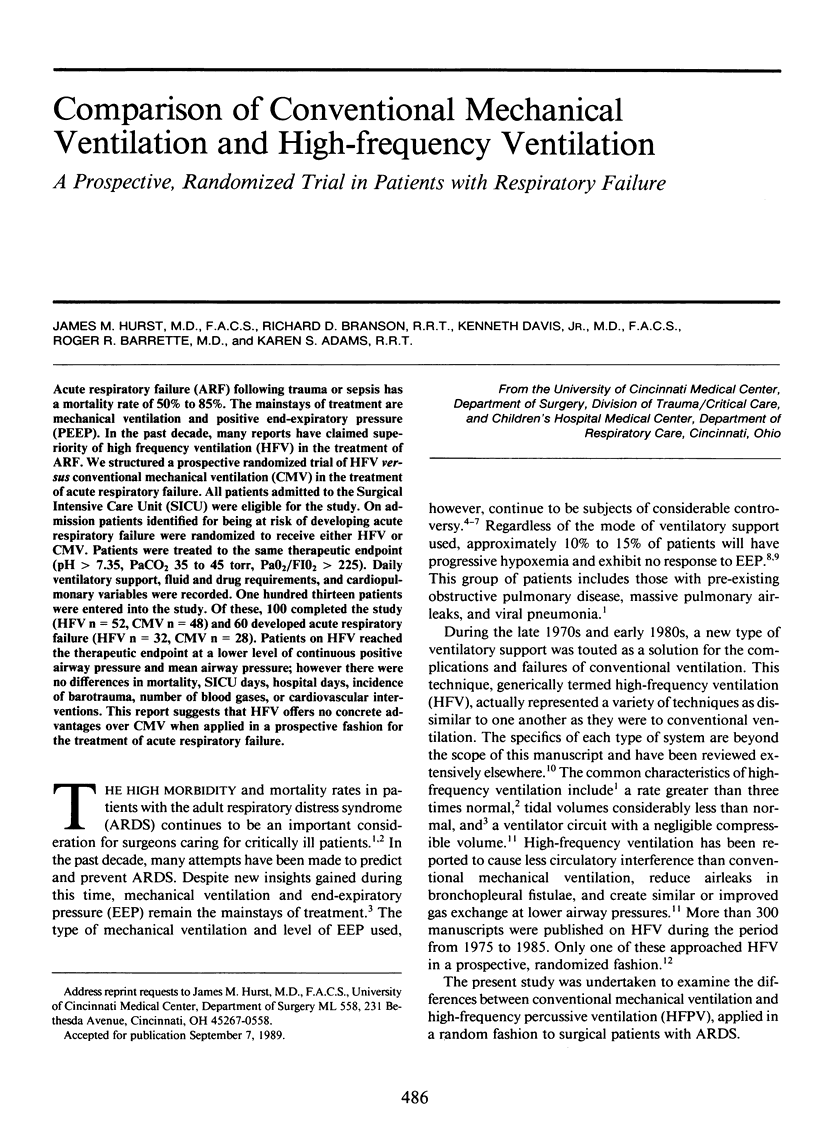
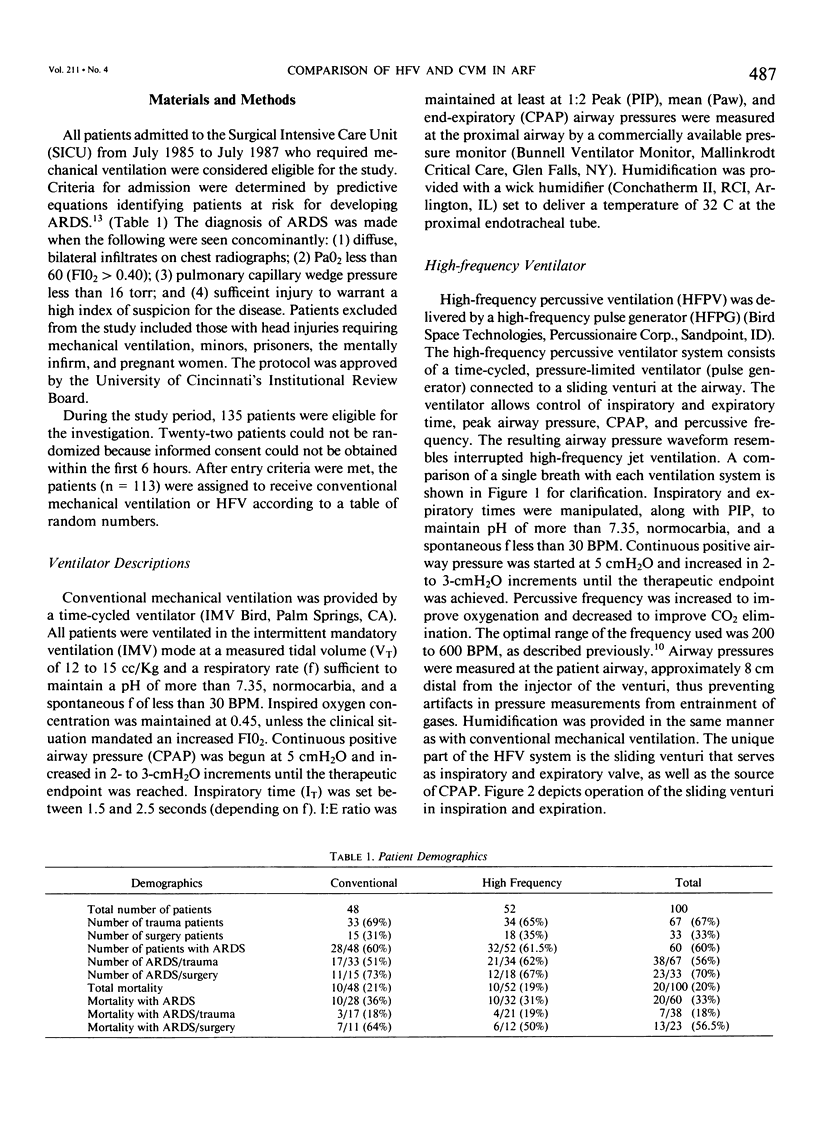
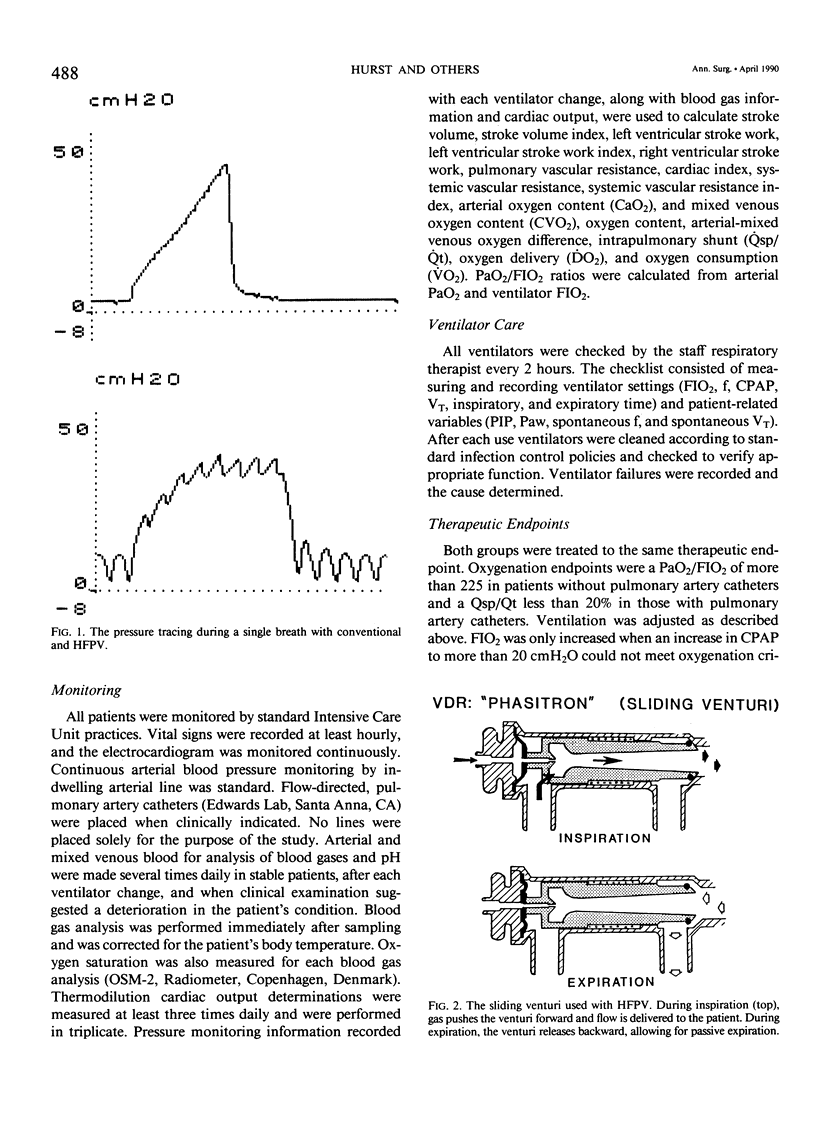
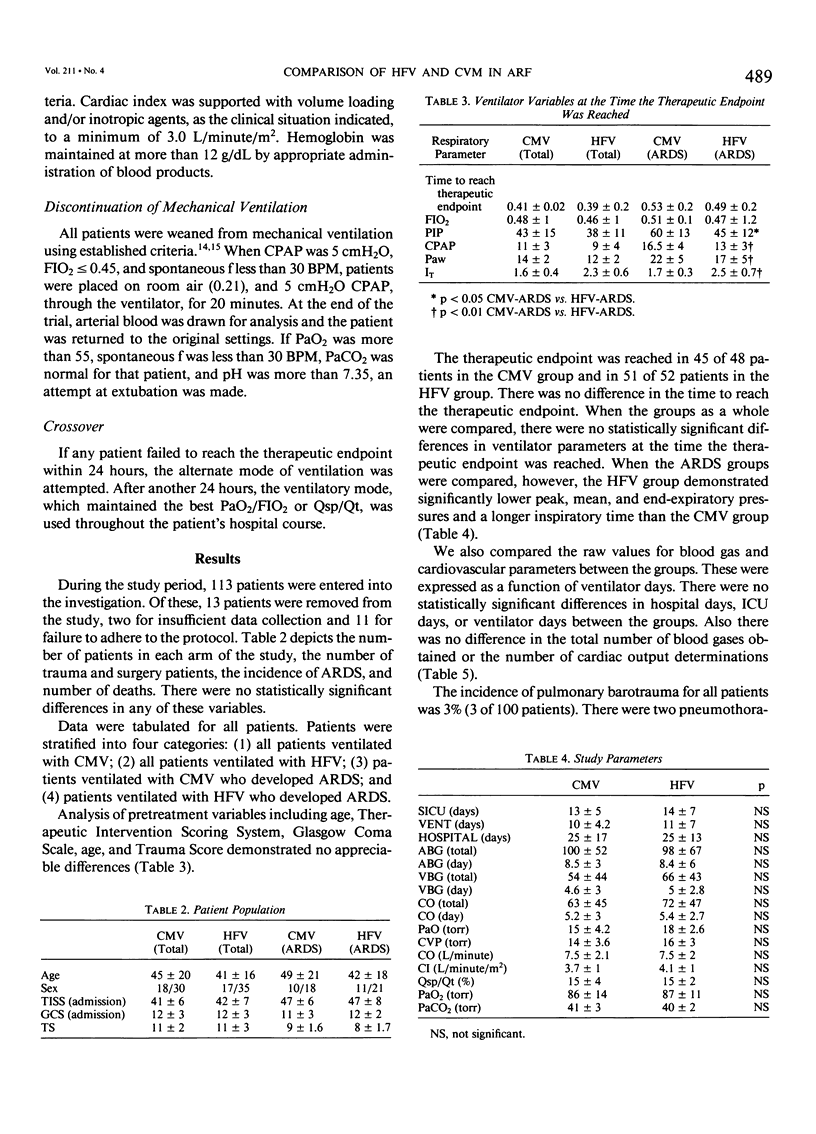
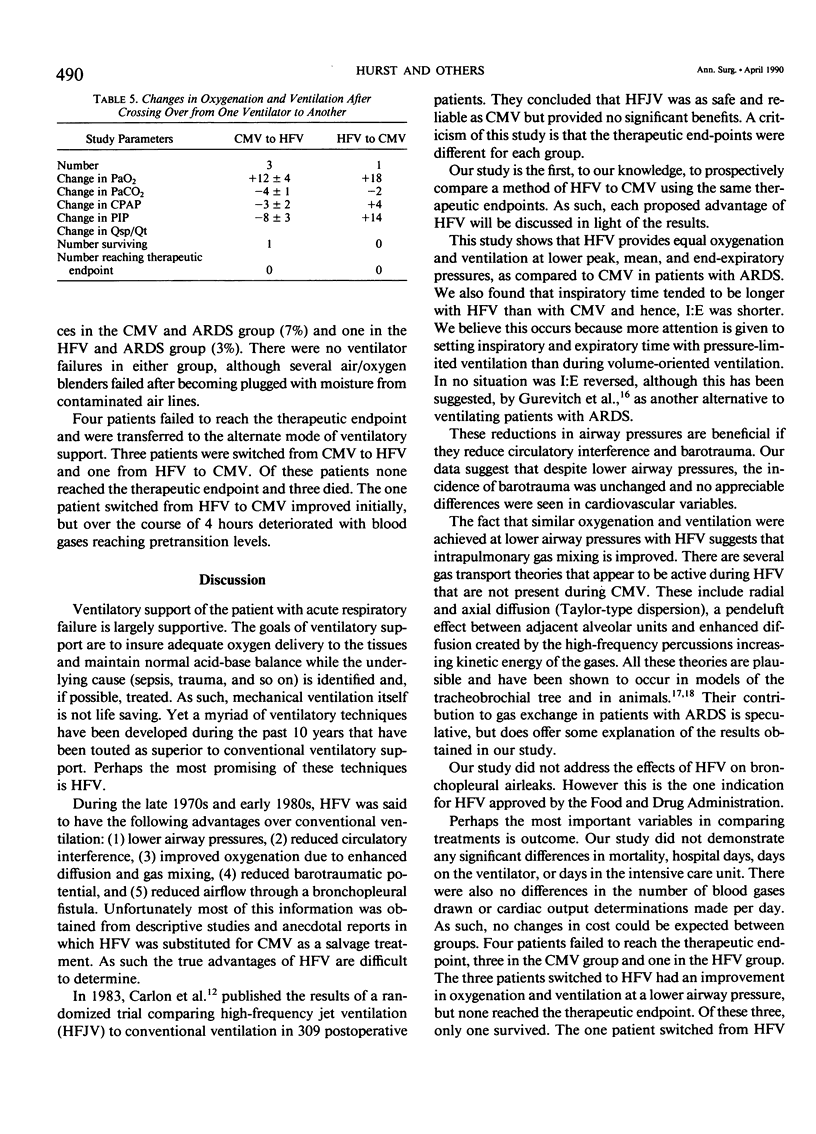
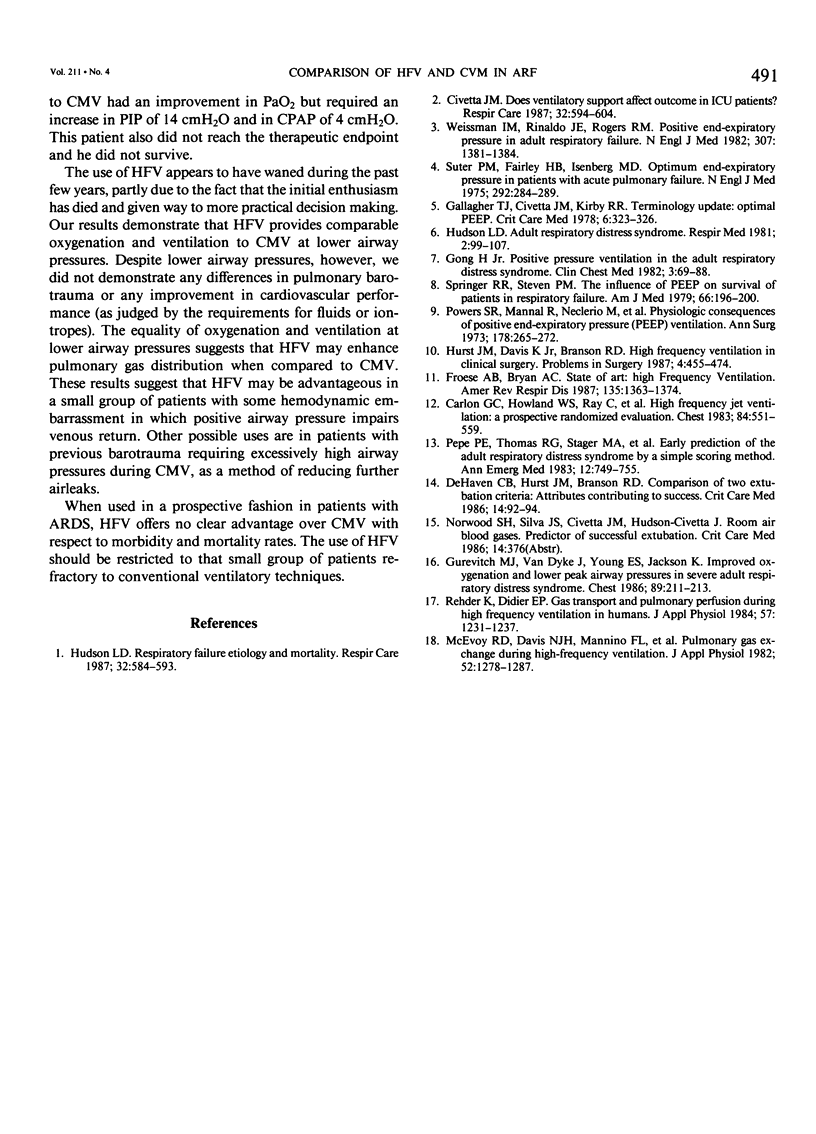
Selected References
These references are in PubMed. This may not be the complete list of references from this article.
- Carlon G. C., Howland W. S., Ray C., Miodownik S., Griffin J. P., Groeger J. S. High-frequency jet ventilation. A prospective randomized evaluation. Chest. 1983 Nov;84(5):551–559. doi: 10.1378/chest.84.5.551. [DOI] [PubMed] [Google Scholar]
- Civetta J. M. Does ventilatory support affect outcome in ICU patients? Respir Care. 1987 Jul;32(7):594–604. [PubMed] [Google Scholar]
- DeHaven C. B., Jr, Hurst J. M., Branson R. D. Evaluation of two different extubation criteria: attributes contributing to success. Crit Care Med. 1986 Feb;14(2):92–94. doi: 10.1097/00003246-198602000-00003. [DOI] [PubMed] [Google Scholar]
- Froese A. B., Bryan A. C. High frequency ventilation. Am Rev Respir Dis. 1987 Jun;135(6):1363–1374. doi: 10.1164/arrd.1987.135.6.1363. [DOI] [PubMed] [Google Scholar]
- Gallagher T. J., Civetta J. M., Kirby R. R. Terminology update: optimal PEEP. Crit Care Med. 1978 Sep-Oct;6(5):323–326. doi: 10.1097/00003246-197809000-00005. [DOI] [PubMed] [Google Scholar]
- Gong H., Jr Positive-pressure ventilation in the adult respiratory distress syndrome. Clin Chest Med. 1982 Jan;3(1):69–88. [PubMed] [Google Scholar]
- Gurevitch M. J., Van Dyke J., Young E. S., Jackson K. Improved oxygenation and lower peak airway pressure in severe adult respiratory distress syndrome. Treatment with inverse ratio ventilation. Chest. 1986 Feb;89(2):211–213. doi: 10.1378/chest.89.2.211. [DOI] [PubMed] [Google Scholar]
- McEvoy R. D., Davies N. J., Mannino F. L., Prutow R. J., Schumacker P. T., Wagner P. D., West J. B. Pulmonary gas exchange during high-frequency ventilation. J Appl Physiol Respir Environ Exerc Physiol. 1982 May;52(5):1278–1287. doi: 10.1152/jappl.1982.52.5.1278. [DOI] [PubMed] [Google Scholar]
- Pepe P. E., Thomas R. G., Stager M. A., Hudson L. D., Carrico C. J. Early prediction of the adult respiratory distress syndrome by a simple scoring method. Ann Emerg Med. 1983 Dec;12(12):749–755. doi: 10.1016/s0196-0644(83)80250-9. [DOI] [PubMed] [Google Scholar]
- Powers S. R., Jr, Mannal R., Neclerio M., English M., Marr C., Leather R., Ueda H., Williams G., Custead W., Dutton R. Physiologic consequences of positive end-expiratory pressure (PEEP) ventilation. Ann Surg. 1973 Sep;178(3):265–272. doi: 10.1097/00000658-197309000-00005. [DOI] [PMC free article] [PubMed] [Google Scholar]
- Rehder K., Didier E. P. Gas transport and pulmonary perfusion during high-frequency ventilation in humans. J Appl Physiol Respir Environ Exerc Physiol. 1984 Oct;57(4):1231–1237. doi: 10.1152/jappl.1984.57.4.1231. [DOI] [PubMed] [Google Scholar]
- Springer R. R., Stevens P. M. The influence of PEEP on survival of patients in respiratory failure: a retrospective analysis. Am J Med. 1979 Feb;66(2):196–200. doi: 10.1016/0002-9343(79)90527-8. [DOI] [PubMed] [Google Scholar]
- Suter P. M., Fairley B., Isenberg M. D. Optimum end-expiratory airway pressure in patients with acute pulmonary failure. N Engl J Med. 1975 Feb 6;292(6):284–289. doi: 10.1056/NEJM197502062920604. [DOI] [PubMed] [Google Scholar]
- Weisman I. M., Rinaldo J. E., Rogers R. M. Current concepts: positive end-expiratory pressure in adult respiratory failure. N Engl J Med. 1982 Nov 25;307(22):1381–1384. doi: 10.1056/NEJM198211253072205. [DOI] [PubMed] [Google Scholar]


